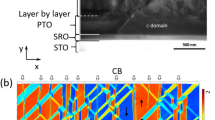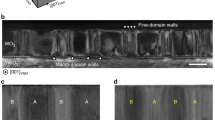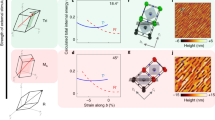Abstract
Domains and domain walls are critical in determining the response of ferroelectrics, and the ability to controllably create, annihilate, or move domains is essential to enable a range of next-generation devices. Whereas electric-field control has been demonstrated for ferroelectric 180° domain walls, similar control of ferroelastic domains has not been achieved. Here, using controlled composition and strain gradients, we demonstrate deterministic control of ferroelastic domains that are rendered highly mobile in a controlled and reversible manner. Through a combination of thin-film growth, transmission-electron-microscopy-based nanobeam diffraction and nanoscale band-excitation switching spectroscopy, we show that strain gradients in compositionally graded PbZr1−xTixO3 heterostructures stabilize needle-like ferroelastic domains that terminate inside the film. These needle-like domains are highly labile in the out-of-plane direction under applied electric fields, producing a locally enhanced piezoresponse. This work demonstrates the efficacy of novel modes of epitaxy in providing new modalities of domain engineering and potential for as-yet-unrealized nanoscale functional devices.
This is a preview of subscription content, access via your institution
Access options
Subscribe to this journal
Receive 12 print issues and online access
$259.00 per year
only $21.58 per issue
Buy this article
- Purchase on Springer Link
- Instant access to full article PDF
Prices may be subject to local taxes which are calculated during checkout





Similar content being viewed by others
References
Roitburd, A. L. Equilibrium structure of epitaxial layers. Phys. Status Solidi 37, 329–339 (1976).
Foster, C. M., Pompe, W., Daykin, A. C. & Speck, J. S. Relative coherency strain and phase transformation history in epitaxial ferroelectric thin films. J. Appl. Phys. 79, 1405–1415 (1996).
Kwak, B. S. et al. Strain relaxation by domain formation in epitaxial ferroelectric thin films. Phys. Rev. Lett. 68, 3733–3736 (1992).
Setter, N. et al. Ferroelectric thin films: review of materials, properties, and applications. J. Appl. Phys. 100, 051606 (2006).
Li, D. & Bonnell, D. A. Controlled patterning of ferroelectric domains: fundamental concepts and applications. Annu. Rev. Mater. Res. 38, 351–368 (2008).
Karthik, J., Agar, J. C., Damodaran, A. R. & Martin, L. W. Effect of 90° domain walls and thermal expansion mismatch on the pyroelectric properties of epitaxial PbZr0.2Ti0.8O3 thin films. Phys. Rev. Lett. 109, 257602 (2012).
Feigl, L. et al. Controlled stripes of ultrafine ferroelectric domains. Nature Commun. 5, 4677 (2014).
Chen, L. et al. Formation of 90° elastic domains during local 180° switching in epitaxial ferroelectric thin films. Appl. Phys. Lett. 84, 254–256 (2004).
Mangalam, R. V. K., Karthik, J., Damodaran, A. R., Agar, J. C. & Martin, L. W. Unexpected crystal and domain structures and properties in compositionally graded PbZr1−xTixO3 thin films. Adv. Mater. 25, 1761–1767 (2013).
Seidel, J. et al. Conduction at domain walls in oxide multiferroics. Nature Mater. 8, 229–234 (2009).
Karthik, J., Damodaran, A. R. & Martin, L. W. Effect of 90° domain walls on the low-field permittivity of PbZr0.2Ti0.8O3 thin films. Phys. Rev. Lett. 108, 167601 (2012).
Zednik, R. J., Varatharajan, A., Oliver, M., Valanoor, N. & McIntyre, P. C. Mobile ferroelastic domain walls in nanocrystalline PZT films: the direct piezoelectric effect. Adv. Funct. Mater. 21, 3104–3110 (2011).
Karthik, J. & Martin, L. W. Pyroelectric properties of polydomain epitaxial Pb(Zr1−x, tTix)O3 thin films. Phys. Rev. B 84, 024102 (2011).
Seidel, J. Domain walls as nanoscale functional elements. J. Phys. Chem. Lett. 3, 2905–2909 (2012).
Catalan, G., Seidel, J., Ramesh, R. & Scott, J. F. Domain wall nanoelectronics. Rev. Mod. Phys. 84, 119–156 (2012).
Farokhipoor, S. et al. Artificial chemical and magnetic structure at the domain walls of an epitaxial oxide. Nature 515, 379–383 (2014).
Zeches, R. J. et al. A strain-driven morphotropic phase boundary in BiFeO3 . Science 326, 977–980 (2009).
Salje, E. & Zhang, H. Domain boundary engineering. Phase Transit. 82, 452–469 (2009).
Vasudevan, R. et al. Domain wall geometry controls conduction in ferroelectrics. Nano Lett. 12, 5524–5531 (2012).
Guyonnet, J., Gaponenko, I., Gariglio, S. & Paruch, P. Conduction at domain walls in insulating Pb(Zr0.2Ti0.8)O3 thin films. Adv. Mater. 23, 5377–5382 (2011).
Maksymovych, P. et al. Tunable metallic conductance in ferroelectric nanodomains. Nano Lett. 12, 209–213 (2012).
Xu, R., Karthik, J., Damodaran, A. R. & Martin, L. W. Stationary domain wall contribution to enhanced ferroelectric susceptibility. Nature Commun. 5, 3120 (2014).
McGilly, L. J., Yudin, P., Feigl, L., Tagantsev, A. K. & Setter, N. Controlling domain wall motion in ferroelectric thin films. Nature Nanotech. 10, 145–150 (2015).
Su, D. et al. Origin of 90° domain wall pinning in Pb(Zr0.2Ti0.8)O3 heteroepitaxial thin films. Appl. Phys. Lett. 99, 102902 (2011).
Nagarajan, V. et al. Dynamics of ferroelastic domains in ferroelectric thin films. Nature Mater. 2, 43–47 (2003).
Roelofs, A. et al. Depolarizing-field-mediated 180° switching in ferroelectric thin films with 90° domains. Appl. Phys. Lett. 80, 1424–1426 (2002).
Khan, A. I., Marti, X., Serrao, C., Ramesh, R. & Salahuddin, S. Voltage-controlled ferroelastic switching in Pb(Zr0.2Ti0.8)O3 thin films. Nano Lett. 15, 2229–2234 (2015).
Feigl, L., McGilly, L., Sandu, C. & Setter, N. Compliant ferroelastic domains in epitaxial Pb(Zr, Ti)O3 thin films. Appl. Phys. Lett. 104, 172904 (2014).
Wessels, B. W. Ferroelectric epitaxial thin films for integrated optics. Annu. Rev. Mater. Res. 37, 659–679 (2007).
Scrymgeour, D. Ferroelectric Crystals for Photonic Applications 385–399 (Springer, 2014).
Scott, J. F. Ferroelectric Memories (Springer Science Business Media, 2000).
Scott, J. F. Applications of modern ferroelectrics. Science 315, 954–959 (2007).
Agar, J. C. et al. Complex evolution of built-in potential in compositionally-graded PbZr1−xTixO3 thin films. ACS Nano 9, 7332–7342 (2015).
Mangalam, R. V. K., Agar, J. C., Damodaran, A. R., Karthik, J. & Martin, L. W. Improved pyroelectric figures of merit in compositionally graded PbZr1−xTixO3 thin films. ACS Appl. Mater. Interfaces 5, 13235–13241 (2013).
Jesse, S. & Kalinin, S. V. Band excitation in scanning probe microscopy: sines of change. J. Phys. D 44, 464006 (2011).
Speck, J. S., Seifert, A., Pompe, W. & Ramesh, R. Domain configurations due to multiple misfit relaxation mechanisms in epitaxial ferroelectric thin films. II. Experimental verification and implications. J. Appl. Phys. 76, 477–483 (1994).
Ganpule, C. S. et al. Role of 90° domains in lead zirconate titanate thin films. Appl. Phys. Lett. 77, 292–294 (2000).
Lee, K., Choi, J., Lee, J. & Baik, S. Domain formation in epitaxial Pb(Zr, Ti)O3 thin films. J. Appl. Phys. 90, 4095–4102 (2001).
Gao, P. et al. Atomic-scale mechanisms of ferroelastic domain-wall-mediated ferroelectric switching. Nature Commun. 4, 2791 (2013).
Britson, J., Nelson, C., Pan, X. & Chen, L. First-order morphological transition of ferroelastic domains in ferroelectric thin films. Acta Mater. 75, 188–197 (2014).
Catalan, G. et al. Flexoelectric rotation of polarization in ferroelectric thin films. Nature Mater. 10, 963–967 (2011).
Gao, P. et al. Ferroelastic domain switching dynamics under electrical and mechanical excitations. Nature Commun. 5, 3801 (2014).
Karthik, J., Damodaran, A. R. & Martin, L. W. Epitaxial ferroelectric heterostructures fabricated by selective area epitaxy of SrRuO3 using an MgO mask. Adv. Mater. 24, 1610–1615 (2012).
Zubko, P., Catalan, G. & Tagantsev, A. K. Flexoelectric effect in solids. Annu. Rev. Mater. Res. 43, 387–421 (2013).
Tagantsev, A. K. & Yurkov, A. S. Flexoelectric effect in finite samples. J. Appl. Phys. 112, 044103 (2012).
Cross, L. E. Flexoelectric effects: charge separation in insulating solids subjected to elastic strain gradients. J. Mater. Sci. 41, 53–63 (2006).
Yudin, P. & Tagantsev, A. Fundamentals of flexoelectricity in solids. Nanotechnology 24, 432001 (2013).
Ozdol, V. B. et al. Strain mapping at nanometer resolution using advanced nano-beam electron diffraction. Appl. Phys. Lett. 106, 253107 (2015).
Acknowledgements
J.C.A., G.A.V. and L.W.M. acknowledge support from the National Science Foundation under grant DMR-1451219. A.R.D. and S.P. acknowledge support from the Army Research Office under grant W911NF-14-1-0104. L.R.D. acknowledges support from the Department of Energy, Basic Energy Sciences under grant No. DE-SC0012375 for chemical studies of the materials. R.V.K.M. acknowledges support from the National Science Foundation under grant CMMI-1434147. R.K.V. and S.V.K. acknowledge support from the Division of Materials Sciences and Engineering, Basic Energy Sciences, Department of Energy. Portions of this research were conducted at the Center for Nanophase Materials Sciences, which is a Department of Energy, Office of Science User Facility sponsored at Oak Ridge National Laboratory by the Scientific User Facilities Division, Basic Energy Sciences, Department of Energy which also provided support for M.B.O., S.J. and N.B. J.K. and A.M.M. acknowledge support from the National Science Foundation CMMI/MoM Program under GOALI Grant 1235610. C.G. acknowledges support from the Austrian Science Fund (FWF):[J3397]. Portions of this work were carried out at the Molecular Foundry, Lawrence Berkeley National Laboratory, which is supported by the US Dept. of Energy under Contract No. DE-AC02-29705CH11231.
Author information
Authors and Affiliations
Contributions
J.C.A. and L.W.M. designed the experiments. J.C.A., R.V.K.M. and G.A.V. grew the films and conducted the macroscopic electrical and structural characterization. L.R.D. completed the Rutherford backscattering spectrometry studies. J.K., C.G. and A.M.M. prepared the samples for STEM and conducted the STEM imaging and nanobeam diffraction strain mapping. J.C.A., J.K., C.G., A.M.M. and L.W.M. analysed the STEM and nanobeam diffraction strain mapping data. M.B.O., S.J., N.B. and S.V.K. designed the custom band-excitation system. J.C.A., M.B.O. and R.K.V. conducted the band-excitation measurements. M.B.O., S.J., R.K.V. and S.V.K. designed the band-excitation fitting and piezoelectric loop fitting algorithm and software. J.C.A., M.B.O., R.K.V., S.J., N.B., S.V.K. and L.W.M. analysed the band-excitation results. J.C.A., A.R.D., S.P. and L.W.M. determined the switching mechanism. J.C.A. and L.W.M. co-wrote the paper.
Corresponding author
Ethics declarations
Competing interests
The authors declare no competing financial interests.
Supplementary information
Supplementary Information
Supplementary Information (PDF 1979 kb)
Supplementary Information
Supplementary movie 1 (MOV 23066 kb)
Supplementary Information
Supplementary movie 2 (MOV 27954 kb)
Rights and permissions
About this article
Cite this article
Agar, J., Damodaran, A., Okatan, M. et al. Highly mobile ferroelastic domain walls in compositionally graded ferroelectric thin films. Nature Mater 15, 549–556 (2016). https://doi.org/10.1038/nmat4567
Received:
Accepted:
Published:
Issue Date:
DOI: https://doi.org/10.1038/nmat4567
This article is cited by
-
In-situ synthesis of gadolinium niobate quasi-binary composites with balanced mechanical and thermal properties for thermal barrier coatings
Journal of Advanced Ceramics (2022)
-
Symmetry-aware recursive image similarity exploration for materials microscopy
npj Computational Materials (2021)
-
Revealing ferroelectric switching character using deep recurrent neural networks
Nature Communications (2019)
-
Sequential piezoresponse force microscopy and the ‘small-data’ problem
npj Computational Materials (2018)
-
Reversible optical control of macroscopic polarization in ferroelectrics
Nature Photonics (2018)



